The Coppings in Montreal
Another friend, John Eveleigh, who was in the leather business in Montreal, also had a lot in Rawdon near the Petries. These family moved to Montreal and again to Rawdon about the same time as the Coppings. The Coppings’ lot was in proximity to both these families.
What was George’s occupation in Montreal? Not surprising documents and church records list him as a sawyer.
Years later son Henry had a saw mill in Montreal.
Some family stories tell of a business in Old Montreal where the children amused themselves sailing paper boats on the St. Pierre River. Others tell of a farm on what is now Papineau Street.
I have found nothing to validate either of these speculations. When Thomas was born George’s occupation was listed as ‘sawyer’ which would be a reasonable conclusion.
Thomas, Henry, and Mary were born in Montreal and baptised in the Christ Church Cathedral.
The Copping family’s oral history tells of George’s son, Charles, being apprenticed in Eveleigh’s leather business in Montreal.
What is known is Charles married Emily Bennet and joined in her father’s in his leather business in New York.
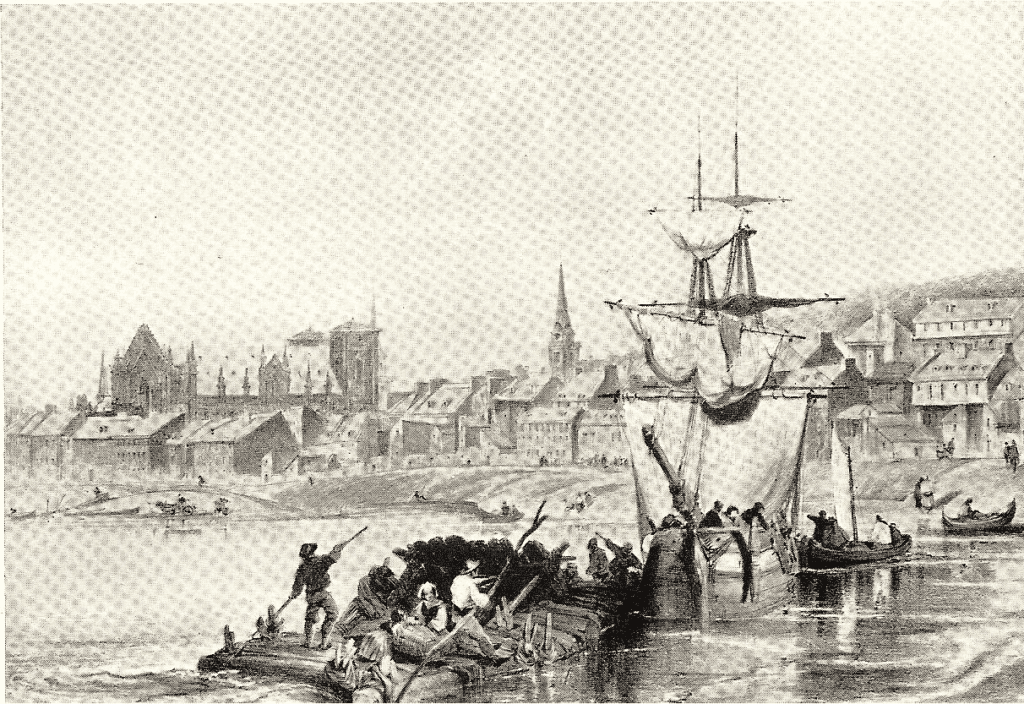
The Approach to Montreal from LaPrairie.
The town was built on a triangle of land at the edge of the river where the original fort of Ste Marie had been built. Across the river the old settlements of La Prairie and Longueuil were visible. The mountain towering in the centre of the island protected the settlement from the blasts of the north wind. Outside the town limits there was good farming land as well as stone quarries.
The glistening tin roofs of houses, nunneries, and churches, gave a magnificent vista to incoming vessels. While the mountain with its woods, orchards, and villas formed a beautiful romantic background to the picture.
Montreal was originally fortified with stone walls against frequent Indian raids. When the fortifications fell into ruins an act of the colonial legislation was passed to demolish the wall. By 1850 most of the wall had disappeared.
Montreal boasted a hundred or more streets, (many wide for the time) lined with a 2,600 houses, several built of locally available stone. Wide, airy, streets, such as rue Notre Dame and rue St Jacques ran parallel to the river. These streets were intersected at right angles by smaller, narrower streets that climbed up from the waterfront. Many of these streets were paved with cobblestones, readily available on the island. A few streets were lit at night and patrolled by foot guards.
As in Quebec City, although there was not the same height, there was a Lower Town and an Upper Town. Lower Town, the port area, had store houses, a custom house, as well as other business establishments and a public market that was held twice a week.
The new upper part of the city was well laid out with good streets. Many of the houses were handsome and offered a splendid view of the city as it was approached from across the river in from LaPrairie.
The Hotel Dieu Hospital was also in the Lower Town.The cathedral, the convent of the Recollets and the Sisters of Notre Dame, were in Upper Town. There were also several private residences in the Upper Town.
Religious edifices, built more solidly than tastefully, all had extensive gardens. The Hotel Dieu, built in 1644, was staffed with a mother superior and 30 nuns who ministered to the sick.
Many of the public buildings are well designed and executed, particularly the courthouse and jail, the Roman Catholic Cathedral, lately erected at expense of 100,000 lbs. The material used for building is a dark gray limestone susceptible to a good shine.
The General Hospital, established in 1753, was on the banks of the St. Lawrence River. It was segregated from the town by a small river. This was a lessor institution with only 19 nuns supervised by a superior.
Many of the public buildings were well designed and executed, particularly the courthouse and jail, the Roman Catholic Cathedral, lately erected at expense of 100,000 pounds.
The material used for building is a dark gray limestone susceptible to a good shine. Shops and houses were generally provided with iron shutters which gave the city a gloomy and prison like appearance on Sunday when places of business were all tightly shuttered.
The present Gibby’s Restaurant is believed to have been a warehouse used to store merchandise, including pearl ash, for shipping. Whenever I dine there I like to imagine my great-great-grandfather was there before me.
The Hudson Bay Company had headquarters in Montreal, notably the exclusive Beaver Club founded in 1785. The rival North West Company also used Montreal as their base.
During the early years of the 19th century, Montreal was in a period of rapid expansion. New settlers, new businesses, were being established. Employment was increasing with introduction of factories and warehouses. The Montreal harbour was developing quickly with the arrival of steamships on the St. Lawrence River.
The soil on the island was much richer than that in the vicinity of Quebec City. The Montreal market was known to be better supplied and offer goods at a much better price.
Where, on the island of Montreal the family settled is uncertain. Two possibilities are offered by the family. One suggestion, that they had a farm on what is today Papineau Street places them well out of the city at that time.
The other theory places them in the heart of the City of Montreal on the St. Pierre River. An article on the Copping family written in 1909 in the now defunct Montreal Star tells of the children floating little boats on the St. Pierre River. I have found no evidence to support either these statements.
What is known about their stay in Montreal is three more children were born while they were there. Thomas, born November 29, 1816, Henry, born August 1, 1818, and a second little girl, Mary, born September 20, 1821. The entry in the Church register gives George’s occupation as “sawyer”, the same trade he plied in Quebec City.
The family remained in Montreal until 1821 when once again, despite the advantages in Montreal, George could not resist the temptation to move to greener pastures.
David Petrie and John Eveleigh, who had recently applied for lots in the newly established Township of Rawdon, convinced George that is was a wonderful opportunity and brought him up to Rawdon. George was impressed with what he saw and filed a request for a lot in proximity to Eveleigh’s. In 1820 he was granted a ticket of location, (the first step to acquire land) for lot 24, range 6.
The following sketches are of areas of Old Montreal the Coppings were familiar with. They spent six years, between 1815 and 1821 living in Montreal.
Once settled in Rawdon the Coppings made a monthly trip delivering pearl ash to a warehouse in the port area. several years ago I spoke with the then owner of Gibby’s Restauant who claimed the building was orininally the warehouse where potash was stored waiting for shipment.
George and Elizabeth also visited Montreal on several occasions, walking the same streets, in the shadow of many of the same buildings, as we would today.
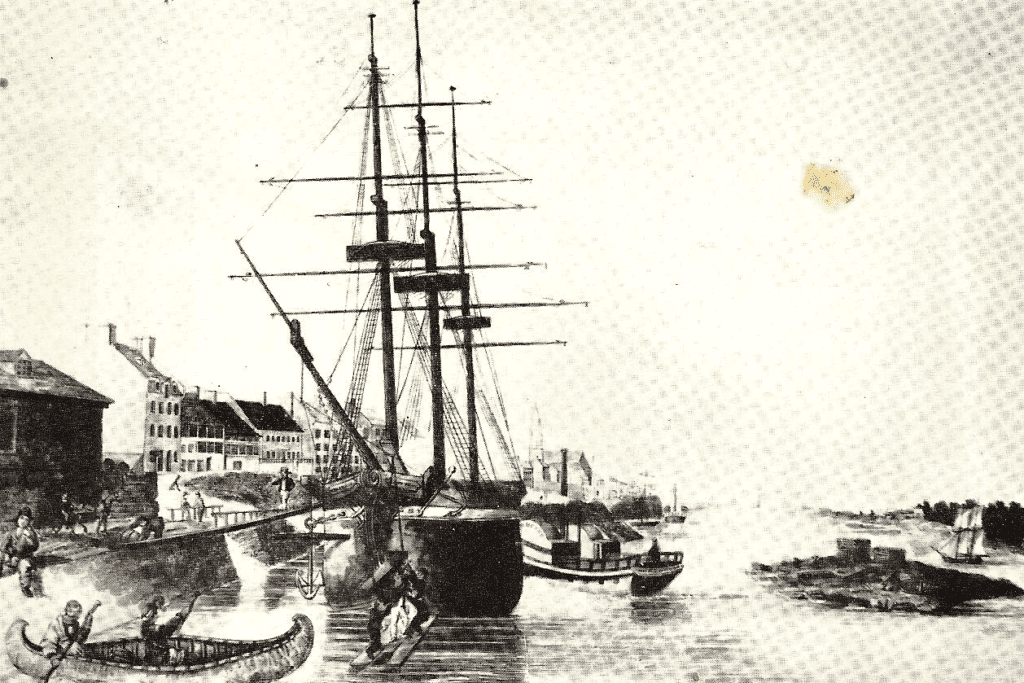
1830 R. A. Sproule
1830 R. A. Sproule
The three masted square rigged ship, Montreal, is shown moored at the wharf. The tug, Henry Lord is visible behind the ship.
Notice the horse being driven along the edge of the water. Oxen and horses were used when loading and unloading boats as well as towing them along the pier.
When the Coppings arrived in 1815 the quay was still in the planning stage.
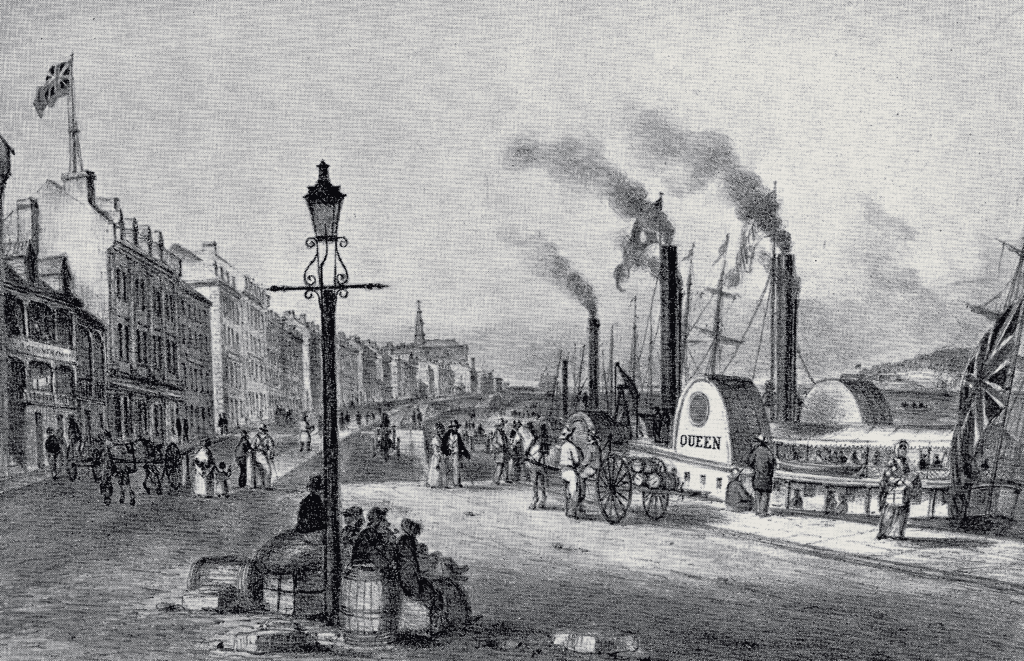
Steamships soon plied the St Lawrence regularly bringing passengers and cargo from Quebec City. A special wharf was built for steamships. Sailboats continued to use their own facility.

1830 John Henry Walker
We can imagine the Copping boys being in this melée when they made their monthly trip to Montreal to deliver their potash to the warehouse on this waterfront.
The boys also visited various shops for items such as yard goods, ribbons, and bonnets, for their mother and sisters. Sometimes their mother accompanied them on their trip.
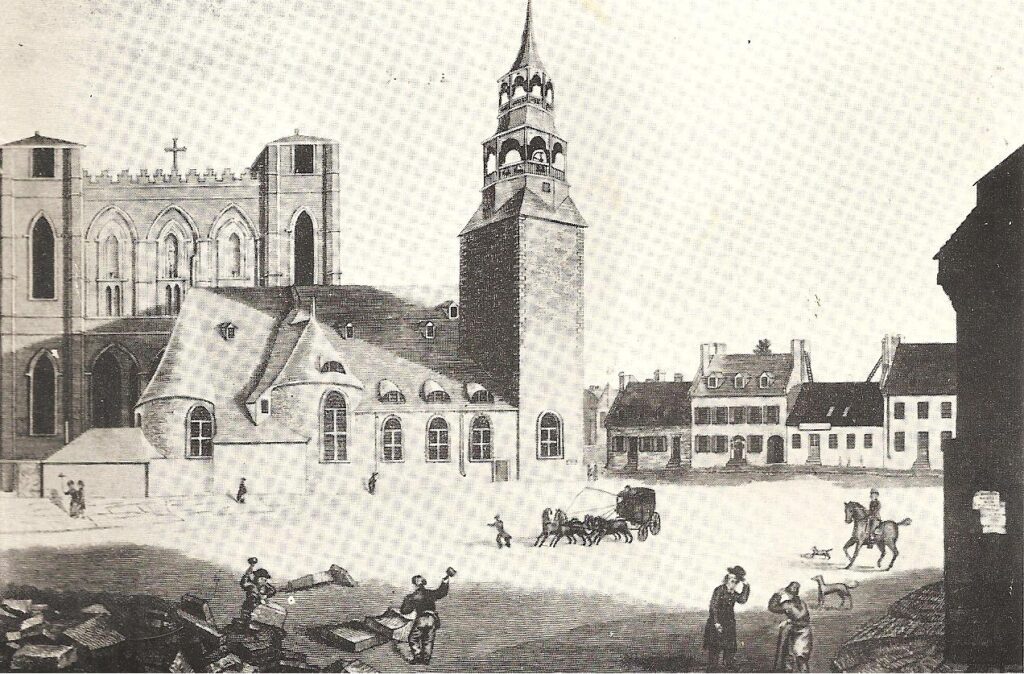
The Church of Notre Dame stood in the middle of Notre dame Street facing the St. Sulpice Seminary (the wall on the lower right hand corner). It was demolished in 1843. In the left background is the Notre Dame Cathedral completed in 1829 except for the towers which were built later. The Tower of Perseverance (the west tower) was completed in 1841, the second tower, Temperance, was completed in 1842.
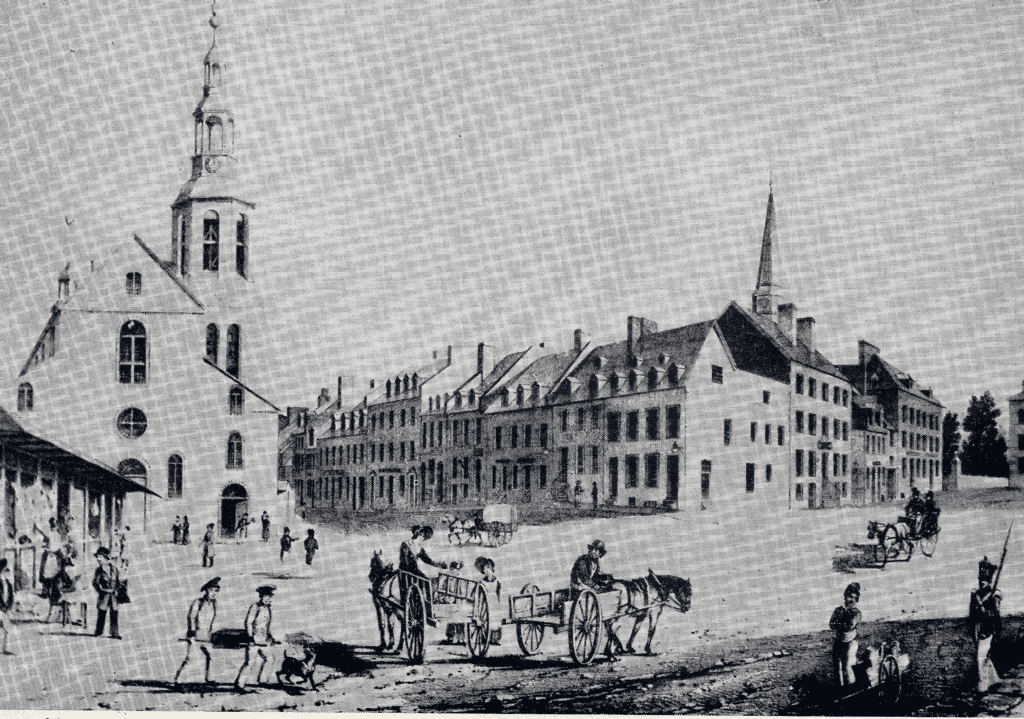
The Bonsecours Church is to the left.
The three masted square rigged ship, Montreal, is shown moored at the wharf. The tug, Henry Lord is visible behind the ship. Notice the horse being driven along the edge of the water. Oxen and horses were used when loading and unloading boats as well as towing them along the pier.
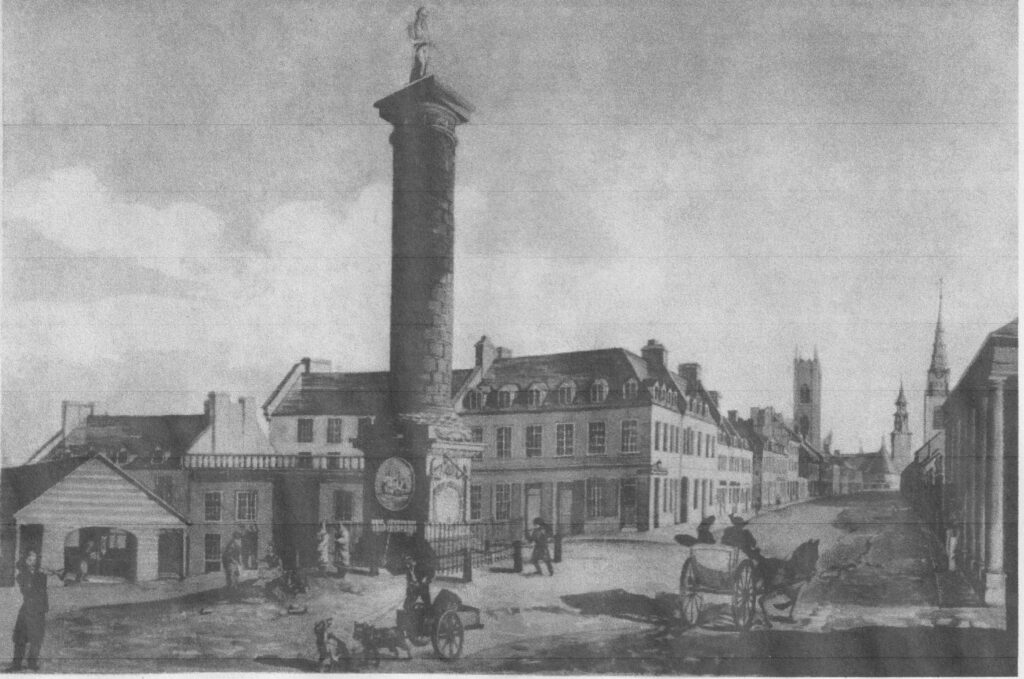
There were two marketplaces in Montreal, the lower market at the Bonsecour Church,the upper market in proximity to the monument to Lord Nelson, the naval hero.
A certain Andrew Oliver claimed the “Montreal markets excelled any market in North America, a rather big claim.
Market days were Monday and Friday in the Bonsecours area of Old Montreal. Friday was the busiest day. Farmers started to arrive at five in the morning with their carts or sleighs of produce. The market went on until about noon.
The upper market sold firewood, hay, etc.
Wood was sold by the cart load. Hard wood – maple, ash, elm & oak, cut in 2 foot lengths and split. Five shillings was the usual price for a cart load. Soft wood was not purchased for fuel.
The lower market was approached from St. Paul Street. Two rows of farm carts were lined up offering wheat, flour, Indian corn, potatoes, pork, mutton, live sheep, geese, turkeys, ducks, chickens, etc. In the winter milk was taken to market frozen in little blocks. Butter was packed in little barrels and eggs were carefully placed in baskets.
This was where the Coppings brought their monthly barrel of pearlash to be shipped overseas. The money from these trips financed a farm for each of the boys, except Joseph who got the homestead.
In spring fresh maple sugar was sold in cakes. The fall brought tobacco, twisted into ropes and coiled.
Rush bottomed chairs made by a handy country man could fetch as much as five shillings, a rather tempting price in that time.
Plaster lathes, etc., were also sold at the market. February 1837 instead of taking potash on the usual monthly trip to Montreal the Copping boys cut and bound 5,000 lathes for sale on the market. George spent several days helping to bind them up into bundles of 100 and loading them onto the sleigh before James and Henry set out for Montreal. The trip would usually take 4 days, but due to bad weather and bad roads it was 5 days before they returned.
When they returned the news was not good. They got a very poor price for their lathes, barely enough to cover expenses and they lost Young George’s set of sleigh bells. They went back to potash.
Leather merchants sold shoes, trunks, etc. Shoes were mostly of a light kind and sold about four shillings a pair. Harness, both heavy and light, for work and for show was available.
Aboriginals brought their wares in to the market, as well. One might find a birch bark canoe, deer skin clothes, moccasins, or a variety of birch bark containers.
In season, several varieties of fish, packed in barrels, were sold. During the winter months the fish were frozen and corded like stove wood.
Nearby taverns were always crowded on market days. The main drink was grog. Wine, brandy, gin, ale, cider, and spruce beer were also available.
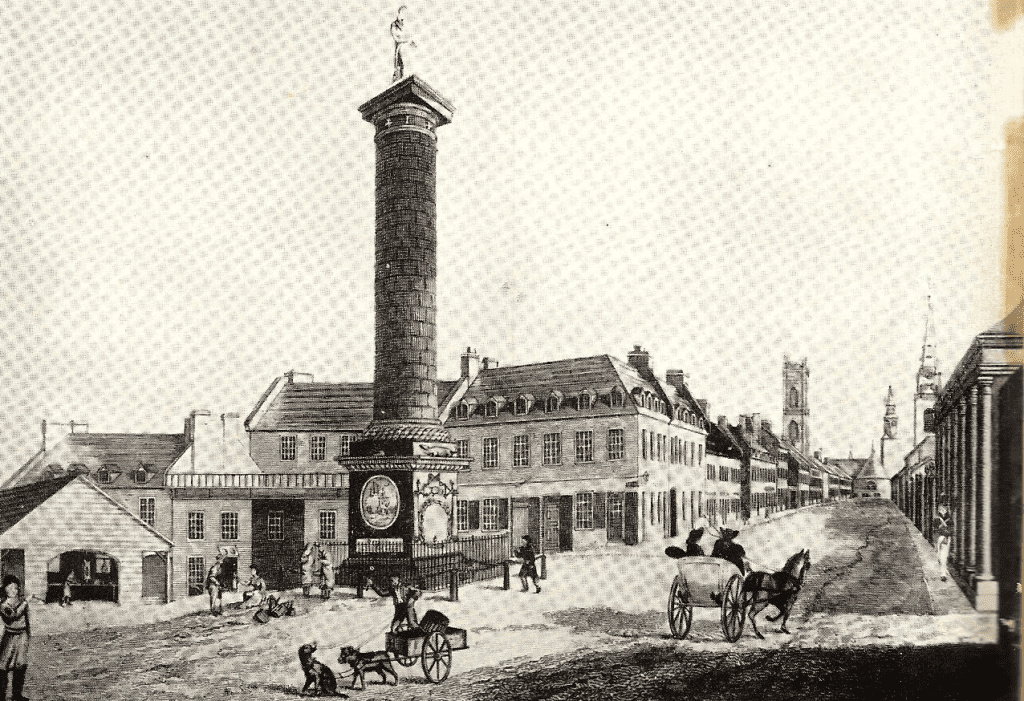
The Nelson Column is visible on the left. The Chateau de Ramzay on the right forefront is now a museum. When the Americans were thwarted in their attempt to annex Lower Canada, November 12, 1775, Benjamin Franklin was sent up to persuade the people of the advantage in joining the United States. He set up a printing press in the basement of the Chateau de Ramzey where he printed flyers and pamphlets urging the people to change their minds. In this he did not succeed but he did establish a printing craft in Montreal which became the Montreal Gazette, now the only English daily newspaper in Montreal.
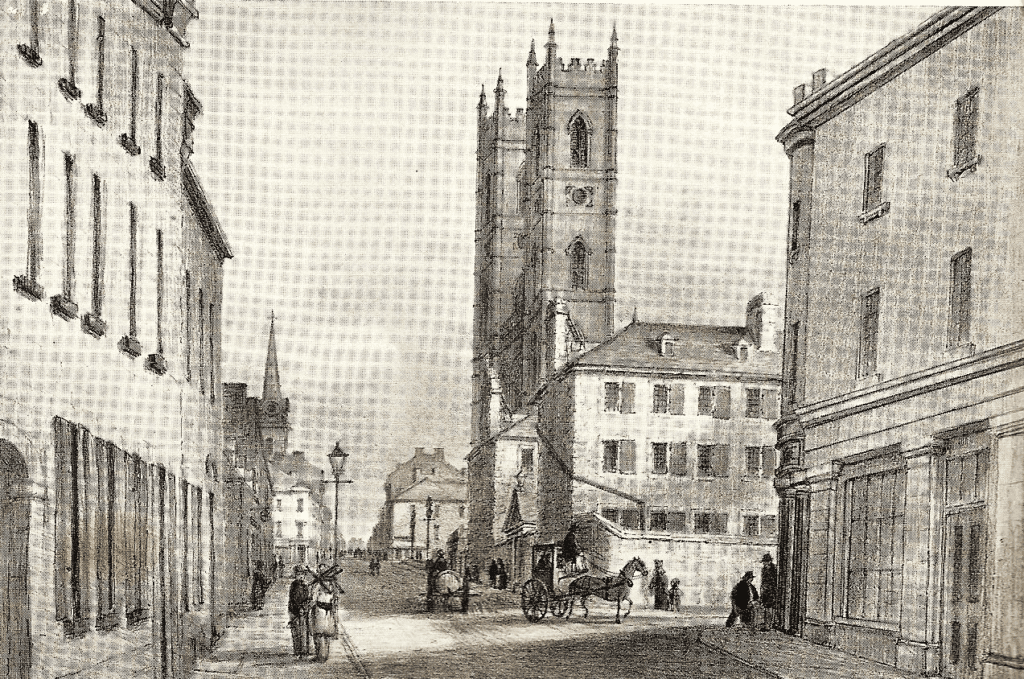
Notre Dame Street was divided into two, separated by Notre Dame Cathedral seen in the right background facing onto Place d’Armes.
Many of these buildings, well known to the Coppings, are still standing today.
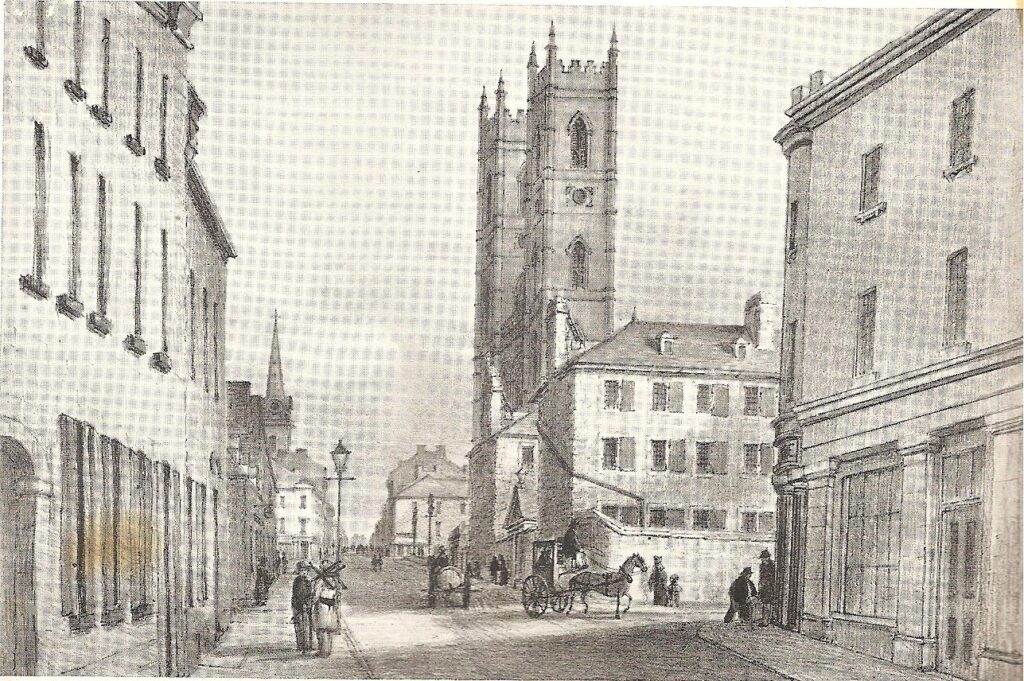
There were several churches and products and places of worship in the city, the principal one was Notre Dame Cathedral, still under construction when the Coppings arrived.
There were considerable number of charitable instrument institutions, colleges, seminaries, libraries, and other public buildings, in Montreal.

At the right forefront is the Bank of Montreal, one of two banking institutes in the city. The Bank of Canada was a much larger bank having assets more than 12 times that of the Bank of Montreal.

Early Bank Notes
Although barter was the usual method of trade some money was used. In 1816 Montreal had two banking institutes, the Bank of Montreal and the much larger Bank of Canada.
Montreal also boasted a public library funded by a group of investors and containing more than 6,000 books. Five or six newspapers were published in this thriving metropolis.
The following sketches are of areas of Old Montreal the Coppings were familiar with. They spent six years, between 1815 and 1821 living in Montreal. Later the boys made regular trips delivering pearl ash to warehouses in the port area. According to some the present Gibby’s Restaurant was a warehouse used to store merchandise, including pearl ash, for shipping. Whenever I dine there I like to imagine my great-great-grandfather had been there long before me.
George and Elizabeth also visited Montreal on several occasions, walking the same streets, in the shadow of many of the same buildings, just as we do today.
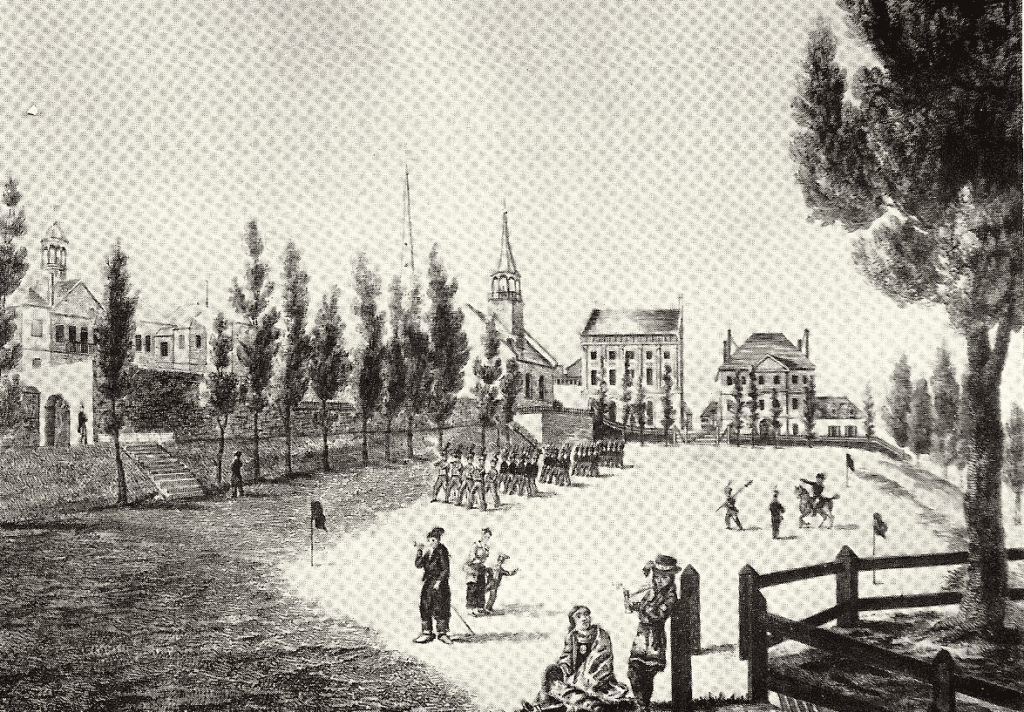
The Champ de Mars, a six acre parcel of land was an agreeable esplanade planted with Lombardy poplars and containing several handsome buildings. The troops of the Garrison were reviewed here, and the military bands performed in the gazebo during the evenings in summer and autumn for the amusement of the fashionables who gathered there.
Watching the military parade was a favourite pastime in Montreal, particularly on Sunday afternoons when they paraded in full uniform. The military band also gave concerts.
Having spent four years in Montreal, once again the Coppings decided to relocate to the new settlement of Rawdon. There they could own a hundred acres of land, all their own that so many were looking for.
One might wonder if they realized the challenge clearing land, building a home in an area without any near neighbours, church, school, that they had in Quebec and Montreal.